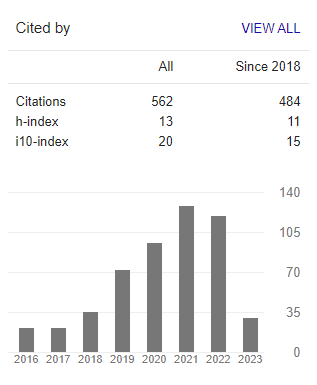STRATEGIC HEALTH RISK COMMUNICATION OF HIV/AIDS ON TWITTER ACCOUNT @hayVeeID
Abstract
This research defines the utilization of the Twitter account @hayVeeID as a strategic communication for health risk communication associated with HIV/AIDS. From year to year, the case of HIV is sadly still increasing. The age range that becomes the majority of the people living with HIV is 20 – 24 Years and 25 – 49 Years. Hence, it is necessary to see the other approach to communicating an infectious disease. The UK's Expert and NGOs propose that the government make online sex education because they are shy about discussing and asking questions if sex education is done in public. Since one of the causes of this infectious disease happens through sexual intercourse and sex education in Indonesia is still taboo, hayVee adapts this online campaign to reduce the number of cases and stigma. This study identifies whether the Twitter account of @hayVeeID can be used as a strategic communication for health risk communication and illustrates the usage of that Twitter account. Using the qualitative approach with an instrumental case study method shows that several aspects of strategic communication need to be improved, such as measurement and the time-bound to achieve their targets. In addition, the social media account of @hayVeeID can be used as well as strategic communication to alter the audience's cognitive, affective, and behavioral components. This finding follows the aspects of attitude change in risk communication.
To cite this article (7th APA style):
Kusuma, R. A. P., & Mulyasari, F. (2022). Strategic health risk communication of HIV/AIDS on twitter account @hayVeeID. Journal Communication Spectrum: Capturing New Perspectives in Communication 12(2), 124-134. https://doi.org/10.36782/jcs.v12i2.2278
Keywords
References
Alexander, A. (2015, June 25). Sexual education: Antara tabu Dan Urgensi. KOMPASIANA. Retrieved January 2, 2020, from https://www.kompasiana.com/andhikaalexander/55113c11813311c12cbc84e8/sexual-education-antara-%20tabu-dan-urgensi
Bennett, P., Calman, K., Curtis, S., & Fischbacher-Smith, D. (2010). Understanding public responses to risk: Policy and practice. In P. Bennett, K. Calman, S. Curtis, & D. Fischbacher-Smith (Eds.), Risk communication and public health (2nd ed., p. 3–22). Oxford University Press. https://doi.org/10.1093/acprof:oso/9780199562848.003.01
Coppola, D. P., & Maloney, E. K. (2017). Communicating emergency preparedness: Practical strategies for the public and private sectors (2nd ed.). Routledge.
Creswell, J. W. (2014). Research Design: Qualitative, Quantitative, and Mixed Methods Approaches. Sage
Fitriyadi, A. R. (2015). Pemanfaatan media sosial Facebook dan Twitter untuk memperkenalkan komunitas Bismania [Bachelor's thesis, Universitas Sultan Ageng Tirtayasa]. https://eprints.untirta.ac.id/501/
hayVee Indonesia. (2019, April 3). A social platform for HIV/AIDS in Indonesia. Kitabisa.com. Retrieved December 16, 2019, from https://kitabisa.com/campaign/hayvee
Herdiansyah, H. (2019). Metodologi penelitian kualitatif untuk ilmu-ilmu sosial: Perspektif konvensional dan kontemporer (2nd ed.). Salemba Humanika.
Kaplan, A. M., & Haenlein, M. (2010). Users of the world, unite! The challenges and opportunities of social media. Business Horizons, 53(1), 59-68. https://doi.org/10.1016/j.bushor.2009.09.003
Kirnandita, P. (2018, February 13). Pengetahuan seks adalah tabu: Bikin malu sekaligus penasaran. tirto.id. Retrieved January 2, 2020, from https://tirto.id/pengetahuan-seks-adalah-tabu-bikin-malu-sekaligus-penasaran-cEHw
Lestari, N. P. (2016). Strategi komunikasi dalam meningkatkan ketertiban lalu lintas pada Satlantas Polresta kota Palembang [Bachelor's thesis, UIN Raden Fatah Palembang]. http://repository.radenfatah.ac.id/5173/
Lianjani, A. (2018). Strategi komunikasi pemerintah kota Tangerang selatan dalam mensosialisasikan program smart city [Bachelor's thesis, UIN Syarif Hidayatullah Jakarta]. http://repository.uinjkt.ac.id/dspace/handle/123456789/41377
Lowbridge, C. P., & Leask, J. (2011). Bug breakfast in the bulletin: Risk communication in public health. New South Wales Public Health Bulletin, 22(2), 34. https://doi.org/10.1071/nb10055
Lundgren, R. E., & McMakin, A. H. (Eds.). (2013). Risk communication: A handbook for communicating environmental, safety, and health risks (5th ed.). Wiley-IEEE Press. https://doi.org/10.1002/9781118645734
Marsden, E. (2017, July 31). Risk perception [PDF document]. Risk-engineering. https://risk-engineering.org/risk-perception/
Miles, M. B., Huberman, A. M., & Saldana, J. (2014). Qualitative Data Analysis: A Methods Sourcebook. Sage
National Research Council. (1989). Improving risk communication. National Academies Press (US). https://doi.org/10.17226/1189
Patterson, S. J., & Radtke, J. M. (2009). Strategic communications for nonprofit organizations: Seven steps to creating a successful plan (2nd ed.). John Wiley & Sons. https://doi.org/10.1002/9781118386804
Patton, M. Q. (2002). Qualitative research & evaluation methods (3rd ed.). SAGE Publications.
Piercy, N., & Giles, W. (1989). Making SWOT analysis work. Marketing Intelligence & Planning, 7(5/6), 5-7. https://doi.org/10.1108/eum0000000001042
Rosalina, Handojo, A., & Wibowo, A. (2015). Aplikasi crowdfunding sebagai perantara penggalangan dana berbasis website dan Facebook application. Jurnal Infra, 3(2). https://publication.petra.ac.id/index.php/teknik-informatika/article/view/3138
Savira, M. (2014). Imunologi human immunodeficiency virus (HIV) dalam Kehamilan. Jurnal Ilmu Kedokteran, 8(1), 1-7. https://doi.org/10.26891/jik.v8i1.2014.1-7
Shaluhiyah, Z., Musthofa, S. B., & Widjanarko, B. (2015). Stigma masyarakat terhadap orang dengan HIV/AIDS. Kesmas: Jurnal Kesehatan Masyarakat Nasional, 9(4), 333-339. https://doi.org/10.21109/kesmas.v9i4.740
Smith, R. D. (2002). Strategic planning for public relations. Lawrence Erlbaum Associates.
Stake, R. E. (1995). The art of case study research. SAGE Publications.
Weller, K., Bruns, A., Burgess, J., Mahrt, M., & Puschmann, C. (Eds.). (2013). Twitter and society. Peter Lang Gmbh.
World Health Organization. (2016). Risk communication applied to food safety: Handbook. https://apps.who.int/iris/handle/10665/250083
Refbacks
- There are currently no refbacks.

This work is licensed under a Creative Commons Attribution 3.0 License.
Indexed by:
Archived in:
Listed in:
INTERNATIONAL ASSOCIATION FOR MEDIA AND COMMUNICATION RESEARCH

















